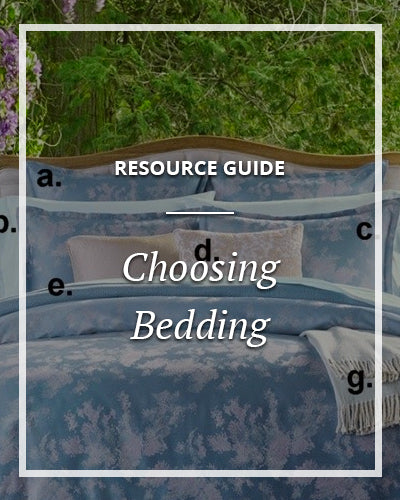Your Cart is Empty
Complimentary Shipping on Orders over $150 (some exclusions apply)
Complimentary Shipping on Orders over $150 (some exclusions apply)

Have a hard time falling asleep? Have you thought about your bedding? We spend a large portion of our life in our bed. Therefore, bedding needs to be comfortable to ensure a good nights sleep. In addition, surrounding ourselves with beautiful items and a beautiful bed encourages us to unwind before nodding off.
A bed is composed of many elements: sheets, pillowcases, blankets, duvets, duvet covers, pillow shams, and more. This can seem overwhelming. Below we've detailed the various components for making a beautiful and luxurious bed.

The above queen bed has the following components | a. Euro Pillow Sham | b. Pillowcases | c. Standard Pillow Sham | d. Decorative Pillow | e. Flat & Fitted Sheet | f. Duvet Cover | g. Throw | h. Bed Skirt
Quality bedding is made from cotton, linen, a cotton/linen blend, or lyocell; because they are all natural fibers that are durable, absorbent, and become softer with use. Quality bedding is smooth, has straight stitching, and finished seams.
At Yvonne Estelle's, we get a number of questions from customers about bedding. Below we've tried to answer the most common questions. If you have a question not answered here, give us a call at (847) 51-1232 and we will be happy to help you over the phone.
What is the difference between percale and sateen bedding? This is our most often asked question. Percale and sateen are weave variations on cotton sheeting. Percale is a traditional one-yarn-over, one-yarn under plain weave. Percale typically features a matte finish and is crisp and has a cool feel that improves with every wash. Suffering from hot flashes? ... these are the sheets you want. Sateen has more yarns on the surface creating a silkier, smoother feel. However, because of the weave, sateen sheets sleep hotter. If you are cold at night, these are the sheets you want.
What is the difference between linen and cotton? Linen and cotton are natural fibers that are highly absorbent, durable, and become softer with use. Generally, linen has more texture, but requires pressing after laundering. Cotton has a more substantial feel and is better for producing printed designs. Cotton is the most popular choice for bedding, so it is widely available and generally more affordable. Egyptian cotton is considered to be the finest variety of cotton in the world and is the most desirable for bedding. Therefore, Egyptian cotton costs more.
Why is Egyptian Cotton the most desirable? The humid weather and rich soil around the Nile delta produces delicate, long cotton fibers. These longer fibers allow for a finer diameter and a more continuous thread which when woven creates a fabric with more drape, a smoother feel, and a softer fabric. This thread can also be woven into a higher number of threads per square inch. This is why high-thread count cotton bedding is Egyptian cotton.
What are the three different types of cotton bedding? Cotton bedding is generally woven into one of three styles: sateen, percale, or a jacquard.
Cotton percale is a closely woven, plain weave; the warp and weft threads cross each other one at a time. Cotton percale has a tight weave with a thread count of at least 180. Cotton percales is used for sheets, cases, shams and duvet covers.
Cotton sateen is woven using a satin weave. Rather than a plain weave, the warp or weft threads pass over several filling threads, creating a fabric with a silken feel and a very smooth and lustrous surface. Cotton sateen can be produced in both light and heavy weights depending on the quality of the fiber and thread. Cotton sateen is used for sheets, cases, shams and duvet covers.
Cotton jacquard is a weave that incorporates a pattern in the weaving process. Due to the weave construction the surface of a jacquard will not feel as smooth as that of percale or sateen. As a result, cotton jacquard is usually only available in shams and duvet covers.
What is thread-count? Thread-count refers to the number of threads in one square inch of fabric. A higher thread counts means a tighter weave, and a softer and stronger fabric. Bedding with a thread-count of 600 or more is generally considered luxurious bedding. While important, thread count should always be considered in conjunction with the quality of the fiber, workmanship and finishing process used on the bedding. Always make sure that the highest quality fiber is used because a high thread count sheet made from lower quality fibers will feel heavy and coarse instead of soft and luxurious.
What is a Matelasse? Matelasse fabrics are woven on a jacquard loom in Portugal, France or Italy. The fabric is a plush textile that appears to be padded, but actually has no padding in the fabric. It is meant to mimic the style of hand-stitched quilts made in Marseilles, France.
How do I care for my bedding? Always wash your bedding before putting it on your bed for the first time. Bedding is manufactured with a starch sizing to facilitate ease of production. This starch can set stains and make bedding feel stiff. Be sure to wash your sheets regularly in cool/warm water with like colors and tumble dry on low. When laundering, do not use bleach or fabric softener because it can damage fibers and make the sheets less soft over time. For less wrinkles in your bedding, remove it promptly from the dryer and put it on the bed or fold it right away. If you do want to iron your bedding, take it out of the dryer slightly damp for easier ironing, and always press embroideries on the reverse side.
If you have a question not answered here, give us a call at (847) 518-1232 and we will be happy to help you over the phone.